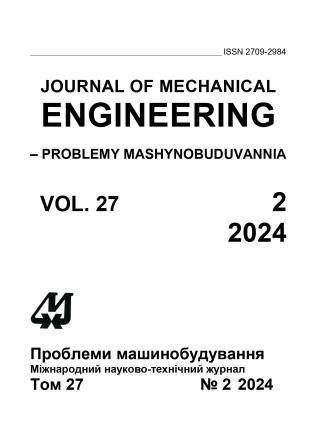Calculation Study of Thermal Stresses in the Medium-Pressure Rotor of the K-200-130 Turbine During Start-Up from a Cold State
Abstract
The paper is devoted to the study of temperature and stress distribution in the medium-pressure rotor of the K-200-130 turbine, which are of considerable interest when predicting the durability of this equipment and extending its operation beyond the service life. A geometric model of the most loaded part of the rotor – from the middle of the shaft neck in the thrust bearing area to the 5th stage disc – was developed. The study of the thermal and stress-strain state of the rotor during start-up from a cold state was performed in a two-dimensional formulation using the finite element method. The non-stationary problem of heat conduction during start-up was solved. The obtained results indicate a fairly uniform thermal state during variable operating conditions. The largest temperature gradient (1200–2200 K/m) is observed at the time points from the rotor push to the synchronization of the turbine generator with the power system. After the turbine generator is loaded with up to 30 MW of electric power, a decrease in the temperature field irregularity and its gradual stabilization are observed. It was found that when operating at the nominal steam parameters, the maximum metal temperature is 508 °C in the region of the control stage and decreases when the distance from it increases. The stress-strain state of the rotor was evaluated taking into account the unevenness of temperature fields during start-up, stresses from thermal expansion, and centrifugal forces. The highest stresses are characteristic of the moment when the turbine comes to idle in the area of thermal compensation grooves of the rotor and the control gate and amount to 440–472 MPa. It is noted that these areas are the most likely zones of ring crack nucleation during turbine start-up operations. Subsequently, the stress level gradually decreases as the turbine unit reaches its rated power. It has been established that the most stressed area of the rotor during stationary operation is the area of the axial bore under the control stage and its diaphragm seal (121–134 MPa).
Downloads
Published
Issue
Section
License
Copyright (c) 2024 С. Р. Ліщук, В. А. Пешко

This work is licensed under a Creative Commons Attribution-NoDerivatives 4.0 International License.
All authors agree with the following conditions:
- The authors reserve the right to claim authorship of their work and transfer to the journal the right of first publication of the work under the license agreement (the agreement).
- Authors have a right to conclude independently additional agreement on non-exclusive spreading the work in the form in which it was published by the jpurnal (for example, to place the work in institution repository or to publish as a part of a monograph), providing a link to the first publication of the work in this journal.
- Journal policy allows authors to place the manuscript in the Internet (for example, in the institution repository or on a personal web sites) both before its submission to the editorial board and during its editorial processing, as this ensures the productive scientific discussion and impact positively on the efficiency and dynamics of citation of published work (see The Effect of Open Access).

